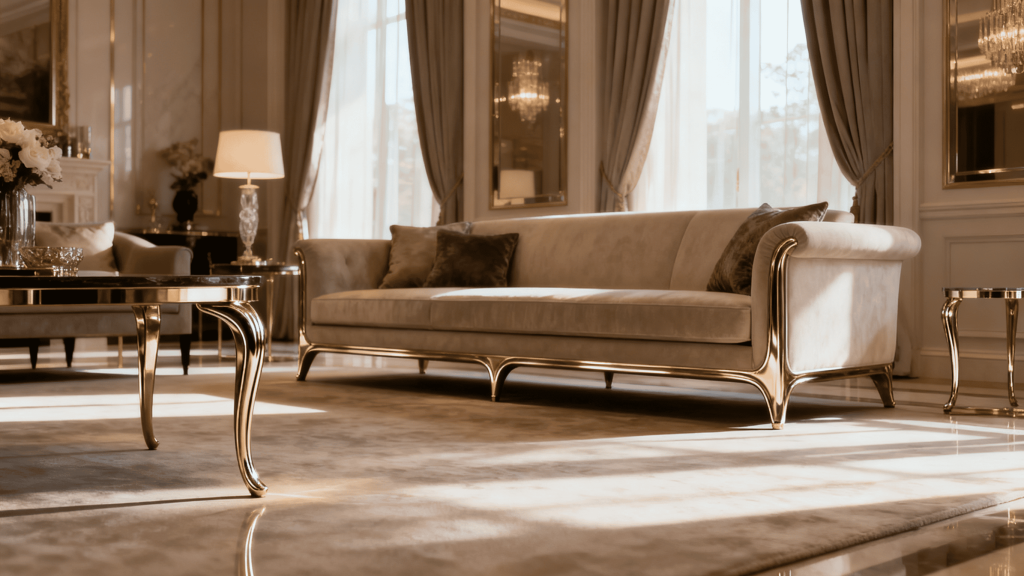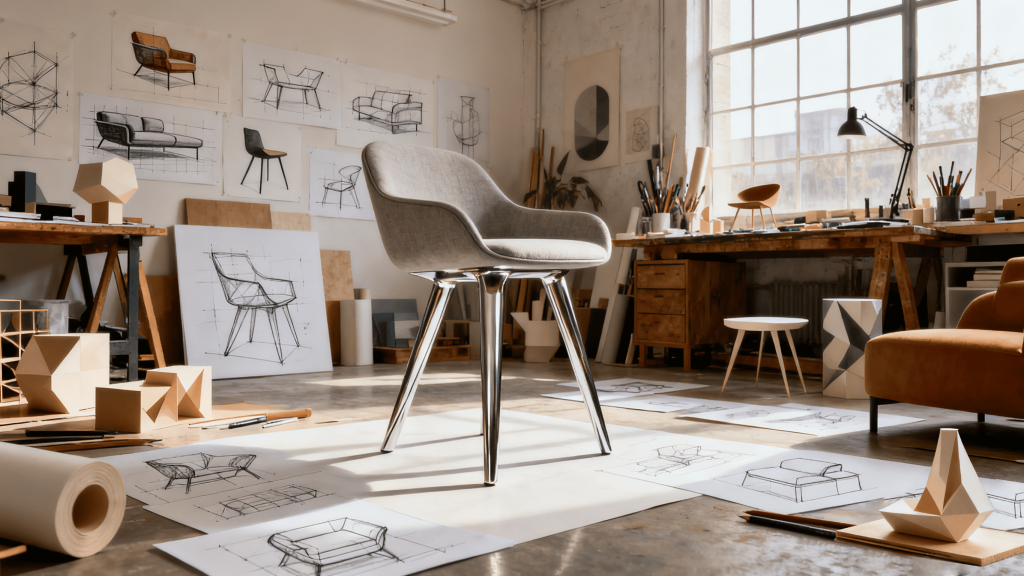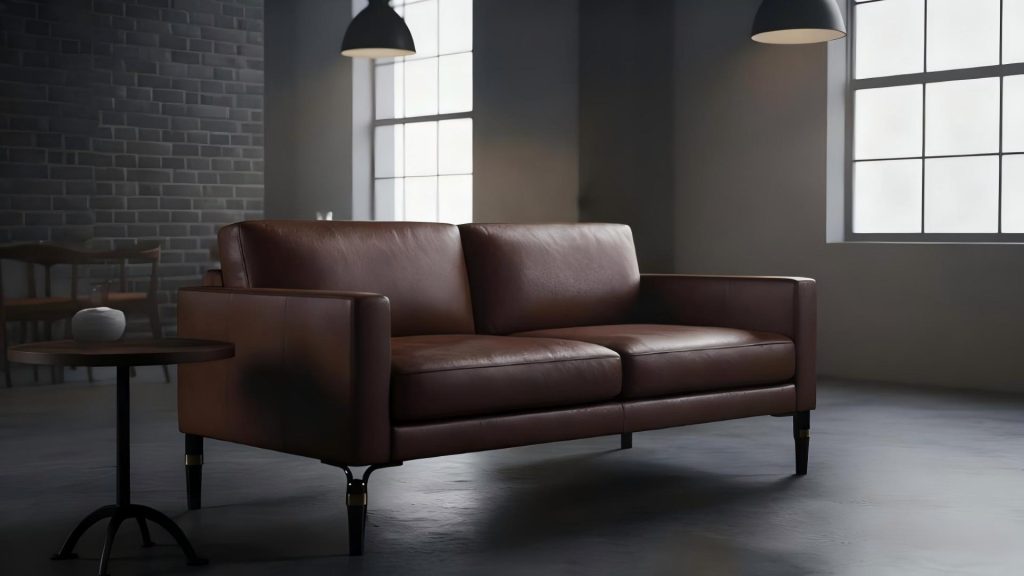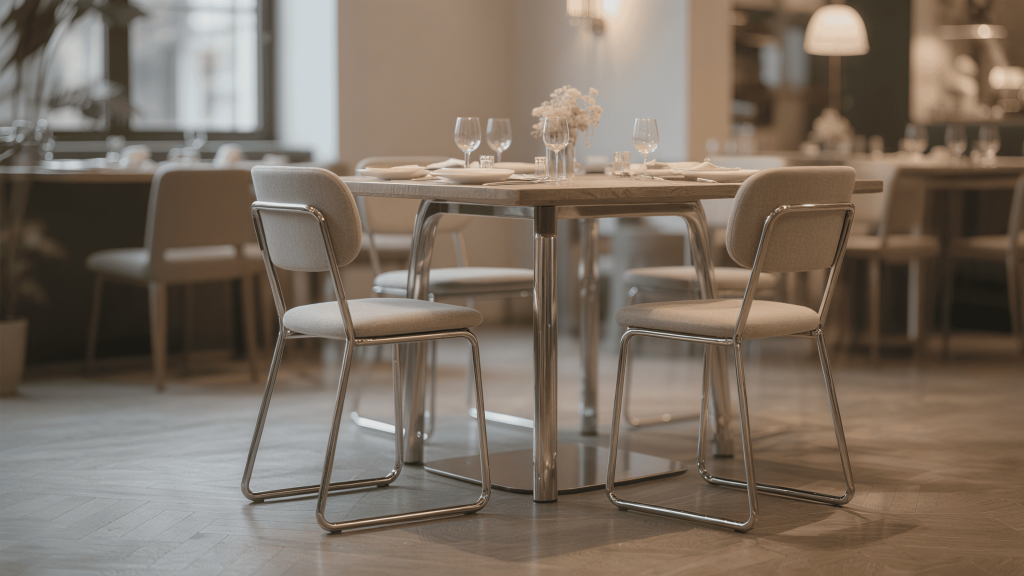
Introduction
Welcome to the world of luxury furniture, where style meets functionality and creativity knows no bounds! The metal furniture legs are not just an afterthought; they are the unsung heroes of modern design. As we dive into the realm of high-end furniture, it’s essential to understand how these components play a pivotal role in shaping the aesthetics and durability of your pieces.
Overview of the Luxury Furniture Market
The luxury furniture market is booming, and it’s not just a passing trend. In fact, it was valued at USD 141.2 billion in 2020, with expectations to grow at a compound annual growth rate (CAGR) of 5.3% from 2021 to 2028. This surge is driven by consumers seeking personalized and unique pieces that reflect their tastes and lifestyles.
Think about it: when you invest in a piece of luxury furniture, you’re not just buying a product; you’re acquiring an experience! It’s about creating spaces that resonate with your identity, which is why customization has become paramount.
Importance of Customization in Furniture Design
Customization isn’t merely a buzzword-it’s a game-changer. In today’s market, customers are looking for more than just off-the-shelf solutions; they want pieces that speak to their individuality. Enter custom metal table legs! These versatile components can transform any design from mundane to magnificent.
Whether it’s sleek black metal table legs for a minimalist vibe or ornate wrought iron table legs for that vintage flair, customization allows designers to push boundaries and innovate. It creates opportunities for brands to stand out in a crowded marketplace while meeting specific client needs.

Introduction to Metal Furniture Legs as a Key Component
Now, let’s talk about the star of our show-metal furniture legs. These sturdy supports are more than just functional; they add character and style to any piece. From heavy-duty metal legs designed for industrial-style tables to elegant brass furniture legs that elevate contemporary designs, the options are endless!
Incorporating metal into your designs not only enhances durability but also contributes to aesthetic appeal. Think about those stunning hairpin table legs or adjustable metal legs that offer both form and function-perfect for modern living spaces! The right choice can make all the difference between ordinary and extraordinary.
Key Takeaway: Investing in custom metal furniture legs can significantly enhance both the functionality and visual appeal of your pieces, making them stand out in today’s competitive luxury market.
The Role of Co-Engineering in Custom OEM Projects
Definition and Importance of Co-Engineering
Co-engineering is like the buddy system for manufacturers and designers. It’s all about collaboration, where both parties bring their expertise to the table (pun intended!). This partnership is crucial in the custom OEM world, especially when it comes to metal furniture legs. By working together, we can create designs that are not only aesthetically pleasing but also structurally sound.
Think of co-engineering as a recipe: you need the right ingredients (materials, designs) mixed perfectly to bake that delicious cake (the final product). Without collaboration, you risk ending up with a soggy mess instead of a masterpiece!

How Collaboration Enhances Product Development
Collaboration isn’t just a feel-good term; it’s a powerful catalyst for innovation. When designers and manufacturers team up, they can share insights that lead to groundbreaking ideas for custom metal table legs. Here’s how this dynamic duo enhances product development:
- Design Feedback: Immediate feedback from engineers can help refine designs before they hit production.
- Material Insights: Manufacturers can provide valuable information about material properties, ensuring the chosen heavy-duty metal legs meet durability standards.
- Crisis Management: Quick communication helps address issues as they arise-think of it as having a lifeguard on duty during swim practice!
- Cost Efficiency: Working together often uncovers cost-saving opportunities without sacrificing quality.
This collaborative approach ultimately leads to better products that meet market demands while staying within budget constraints. After all, who doesn’t love saving a few bucks while creating stunning furniture?
Case Studies of Successful Co-Engineering Projects
If you’re still skeptical about co-engineering, let’s look at some real-world examples where this approach has led to success in creating unique metal furniture legs.
- The Industrial Chic Table:A collaboration between a designer and an OEM manufacturer resulted in an industrial-style dining table featuring robust stainless steel legs. The combination of modern design and heavy-duty materials captured the essence of contemporary living spaces.
- The Adjustable Height Desk:A tech startup wanted an adjustable desk that could cater to various user preferences. By co-engineering with our team, they developed sleek aluminum supports that offered both durability and style-perfect for any home office!
- The Vintage Revival Sofa:A designer focused on mid-century modern aesthetics partnered with us to create unique wrought iron table bases. The result? A stunning piece that beautifully merges vintage charm with modern functionality.

The U.S. furniture and home furnishings stores industry generated about $120 billion in revenue in 2020, showcasing the vast potential of innovative design solutions like co-engineered metal furniture legs.
These case studies highlight how effective collaboration can lead to innovative products that not only meet consumer demands but also elevate brand identity in a competitive market.
Key Takeaway: Co-engineering is essential for creating high-quality custom metal furniture legs that stand out in today’s luxury market. By collaborating closely, designers and manufacturers can innovate effectively while ensuring functionality and style.
Understanding Metal Furniture Legs

Types of Metal Used in Furniture Legs
When it comes to metal furniture legs, the choice of material can make or break your design. Here’s a quick rundown of some popular options:
- Steel: The heavyweight champion of durability! Steel furniture legs are known for their strength and stability, making them ideal for heavy-duty applications.
- Aluminum: Lightweight yet sturdy, aluminum is perfect for those sleek, modern designs. Think adjustable metal legs that can handle any situation!
- Iron: For a touch of vintage charm, wrought iron table legs add character and elegance to any piece.
- Stainless Steel: This option combines durability with a modern aesthetic, making it popular in contemporary furniture designs.
- Copper and Brass: These metals bring warmth and sophistication, perfect for decorative elements in luxury pieces.
The choice of metal not only impacts the strength but also the overall aesthetic. Whether you’re aiming for industrial vibes with heavy-duty steel or a minimalist look with aluminum, the right material sets the tone for your entire design.
Benefits of Using Metal Over Other Materials
You might be wondering why to choose metal furniture legs over wood or plastic. Well, let’s break it down!
- Durability: Metal is inherently strong and resistant to wear and tear. Unlike wood, it won’t warp or crack over time.
- Aesthetic Versatility: From sleek black metal table legs to ornate brass designs, metal offers a range of styles that can fit any decor theme.
- Sustainability: Many metals are recyclable, making them an eco-friendly option compared to single-use plastics.
- Easier Maintenance: A simple wipe-down is all you need! No need for special cleaners or treatments as you would with wood finishes.
This combination of benefits makes metal an attractive choice for both residential and commercial applications. Plus, with increasing urbanization driving demand for stylish yet functional furniture solutions, the trend towards metal is only going to grow!
The demand for metal furniture is driven by its application in both residential and commercial sectors, with increasing urbanization contributing significantly.
Design Considerations for Metal Furniture Legs
Selecting the right metal furniture legs involves more than just picking a material; it’s about understanding how these components fit into your overall design vision. Here are some key considerations:
- Aesthetics: Ensure that the leg design complements your piece. For example, if you’re going vintage, consider using cast iron furniture feet.
- Functionality: Think about how the legs will be used. Will they support heavy tables? If so, opt for heavy-duty metal legs.
- Sizing: The height and width should be proportionate to the piece they support. Adjustable options can provide flexibility!
- Cohesion with Other Elements: Consider how your chosen leg style interacts with other materials in your design-mixing metals can create stunning contrasts!
The right design choices will not only enhance functionality but also elevate the overall aesthetic of your luxury pieces. With so many options available-from minimalist hairpin table legs to robust industrial-style supports-there’s no limit to what you can create!
Key Takeaway: Understanding the types of metals available and their respective benefits allows you to make informed choices that enhance both functionality and style in your custom furniture designs.
Key Steps in Developing a Custom OEM Project for Metal Legs
Initial Consultation and Requirements Gathering
The journey to crafting the perfect metal furniture legs begins with a detailed consultation. This is where we roll up our sleeves and dive into the nitty-gritty. Understanding your vision, brand aesthetics, and functional requirements is crucial. Here’s what we typically cover:
- Design Intent: What look are you going for? Industrial chic, modern minimalism, or vintage vibes?
- Functional Needs: Will these legs support a heavy dining table or a sleek coffee table?
- Material Preferences: Are you leaning towards durable steel furniture legs or something more decorative like brass?
This initial phase is all about aligning expectations and setting the stage for a successful project.
Prototyping and Design Iterations
Once we have a clear understanding of your needs, it’s time to bring those ideas to life! Prototyping is where creativity meets engineering precision. We’ll create initial designs that can be tested and refined through several iterations. Here’s how it works:
- 3D Models: We develop 3D models to visualize the designs before any metal is cut.
- Physical Prototypes: Creating physical samples helps assess both aesthetics and functionality.
- User Testing: Feedback from potential users can guide adjustments before finalizing the design.
The goal here is to ensure that the final product not only looks great but also performs flawlessly under real-world conditions.
The Role of CAD Modeling in Design Accuracy
CAD (Computer-Aided Design) modeling plays a pivotal role in ensuring accuracy during the design process. Think of it as your digital blueprint, allowing for precise adjustments without wasting materials. Here’s why CAD modeling is essential:
- Precision: CAD software allows us to create highly detailed designs that minimize errors.
- Easier Modifications: Want to tweak dimensions? No problem! Changes can be made quickly and efficiently.
- Simplified Collaboration: Sharing CAD files with stakeholders makes communication smoother than ever!
This technology not only speeds up the design process but also enhances collaboration between designers and manufacturers.
Feedback Loops with Designers and Manufacturers
No project is complete without effective feedback loops! Continuous communication between designers and manufacturers ensures everyone stays on the same page. Here are some key aspects of this process:
- Status Updates: Regular check-ins help address any concerns early on, preventing costly mistakes later.
- Smooth Adjustments: If something isn’t working as planned, quick feedback allows us to pivot without losing momentum.
- Cumulative Insights: Each round of feedback builds upon previous iterations, leading us closer to that perfect custom metal table leg.
This collaborative spirit fosters innovation while keeping your project on track!
Selecting Finishes and Coatings (e.g., Powder Coating Benefits)
The finish can make or break your design! Selecting the right coating not only enhances aesthetics but also adds durability. Enter powder coating-a popular choice for metal furniture legs. Here are some benefits of powder coating:
- Diverse Color Options: From sleek black metal table legs to vibrant hues, powder coating offers endless customization possibilities!
- Dust and Scratch Resistance:: This finish creates a tough exterior that withstands wear-and-tear better than traditional paint.
- Sustainability Factor:: Most powder coatings are environmentally friendly, making them an eco-conscious choice!
This step ensures that your custom metal legs not only look good but stand up against everyday use!
Finalizing Specifications for Production Readiness
The last step before hitting that production button involves fine-tuning specifications. This includes everything from dimensions to material grades. Don’t overlook these details-they are vital for ensuring quality! Key points include:
- Tolerance Levels: : Specify how much deviation from measurements is acceptable-precision matters!
- Selecting Materials: : Confirm all materials meet required standards for durability (think heavy-duty steel vs lightweight aluminum).
- Packing Instructions: : Ensure safe transport by detailing how each leg should be packed for shipping-no one wants a bent leg on arrival!
This meticulous attention to detail sets the stage for successful production, ensuring your custom pieces are ready to shine in the market!
The development process of custom OEM projects for metal furniture legs involves careful planning, prototyping, collaboration, and attention to detail at every step. By following these key steps, you can ensure your final product meets both functional requirements and aesthetic desires.
Sourcing and Manufacturing Considerations
The Importance of ISO Certification in Manufacturing Quality
When it comes to sourcing metal furniture legs, quality is non-negotiable. This is where ISO certification steps in like a superhero in a suit, ensuring that manufacturers adhere to strict quality management standards. Think of it as the gold star on your report card, but for factories! ISO certification means:
- Consistent Quality: You can expect the same high standards every time you order.
- Improved Efficiency: Streamlined processes mean quicker turnaround times.
- Global Recognition: ISO-certified products are trusted worldwide, making your brand more appealing.
Selecting an ISO-certified manufacturer for your custom metal table legs ensures you’re not just getting sturdy supports but also peace of mind that they meet international standards.
Sustainable Sourcing Practices for Materials
Sustainability is no longer just a buzzword; it’s a necessity! As consumers become more eco-conscious, integrating sustainable sourcing practices into your manufacturing process is essential. Here’s how you can embrace sustainability when sourcing materials for industrial furniture legs:
- Recycled Metals: Opt for manufacturers that use recycled steel or aluminum. Not only does this reduce waste, but it also lowers the carbon footprint of your products!
- Sustainable Suppliers: Partner with suppliers who prioritize responsible mining and production practices. This ensures ethical sourcing from start to finish.
- Local Sourcing: Reducing transportation emissions by sourcing materials closer to home can significantly impact sustainability efforts.
This approach not only enhances your brand’s reputation but also aligns with the growing demand for environmentally friendly products in the luxury market.
Key Takeaway: Incorporating sustainable practices in sourcing materials not only benefits the environment but also appeals to modern consumers who prioritize eco-friendly options.
Production Timelines and Managing Lead Times Effectively
No one likes waiting around, especially when it comes to launching new products! Understanding production timelines and effectively managing lead times is critical in ensuring that your metal furniture legs hit the market when you need them. Here are some strategies to keep things moving smoothly:
- Create a Detailed Production Schedule: Outline each step of the manufacturing process from design approval to delivery. This transparency helps everyone stay on track!
- Avoid Last-Minute Changes: Changes late in the game can cause delays. Aim for clear communication during earlier stages to minimize surprises.
- Poor Planning Equals Delays: Anticipate potential bottlenecks by having contingency plans ready-think of them as your safety net!
- Tighten Supplier Relationships: Build strong partnerships with suppliers. Regular communication can help resolve issues quickly and keep timelines intact.
A well-managed production timeline not only ensures timely delivery but also helps maintain quality throughout the entire manufacturing process!
Key Takeaway: Effective management of production timelines and lead times is crucial for timely product launches, so prioritize planning and communication with all stakeholders involved!
Quality Assurance and Testing Protocols for Metal Legs
Common Testing Methods
When it comes to metal furniture legs, ensuring quality is non-negotiable. Think of testing as a rigorous workout regimen for your designs – they need to be put through their paces to prove they can handle the heavy lifting! Here are some common testing methods:
- Load Testing: This involves applying weight to the legs to ensure they can support the intended load without bending or breaking. It’s like a bench press for furniture legs!
- Fatigue Testing: Legs are subjected to repeated stress over time, simulating everyday use. This helps identify how well they hold up under continuous pressure – think of it as a marathon for metal!
- Impact Testing: A test that assesses how well the legs withstand sudden forces. Imagine dropping a heavy object on them; we want to see if they remain unscathed!
- Cyclic Testing: This simulates real-life scenarios where furniture is moved or adjusted frequently, ensuring the legs maintain integrity over time.
By employing these testing protocols, manufacturers can confidently guarantee that their custom metal table legs will stand the test of time – quite literally!
Ensuring Compliance with International Standards
No one wants their beautiful furniture leg designs to crumble under pressure, right? That’s where compliance comes into play! Adhering to international standards ensures that your heavy-duty metal legs meet safety and performance benchmarks recognized globally. Here’s why this is crucial:
- Safety Assurance: Compliance with standards like ISO and ASTM ensures that products are safe for consumer use, minimizing liability risks.
- Market Access: Many countries require compliance certifications for imported goods. Meeting these standards opens doors in international markets.
- Quality Consistency: Following established protocols leads to uniform quality across all production batches, which is essential for brand reputation.
- Sustainability Standards: Increasingly, compliance includes environmental considerations, aligning with consumer expectations for eco-friendly products.
This commitment not only enhances product reliability but also builds customer trust in your brand’s dedication to quality.
Key Takeaway: Implementing robust testing methods and ensuring compliance with international standards are essential steps in delivering high-quality metal furniture legs. These practices not only enhance durability but also establish credibility in the luxury market.
